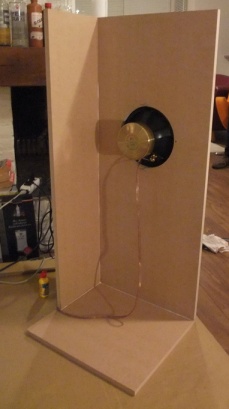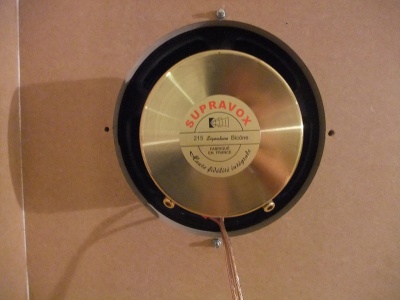| The ChilL-baffle | ||
Updated on: May 17th 2016 |
||
| Introduction | ||
| A few years ago, after reading about and listening to some open-baffle systems, I bought a nice pair of
Supravox 215 Bicone speakers. This speaker was well suited for an open-baffle design due to a high Qts. Also, it has a relatively flat frequency response and a good efficiency (93 dB at 1W/1m). Because of this, it can be used in a single-driver filterless speaker. I had made two experimental baffles to test the driver. Regrettably, the large baffles did not fit well in my living room and had a low GAF (girlfriend acceptance factor). So I was using my Tannoy SGM speakers again and the Supravox units gathered dust... Still, I was thinking about an appropriate design for my living room. If I would make the baffles smaller, they would look better and could fit well in my room. But at the same time, I would lose bass. By making an U-shaped baffle, I could reduce the baffle width and still have enough bass. But with an U-shaped baffle, still box coloration or resonances might appear. Then I got the idea to make an L-shaped baffle... |
||
| The L-shaped baffle | ||
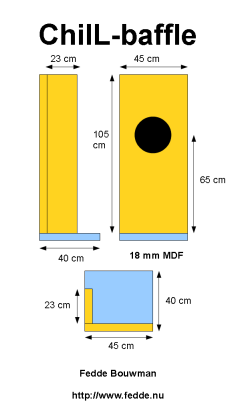 |
||
|
This L-baffle configuration has the following advantages:
|
||
| Construction | ||
|
The construction was really easy! First, I got myself a large plate of 18 mm MDF.
The shop was willing to saw the plate in parts for me. The MDF quality was excellent. I ordered the following plates: Together with a friend, I made the speaker holes (212 mm diameter) and drilled the fixation holes in the front panel. Next, the panels were glued together with quick drying glue. We kept the panels in place with our hands for a few minutes. After waiting for 15 minutes, another layer of glue was added at the corner of the panels. |
||
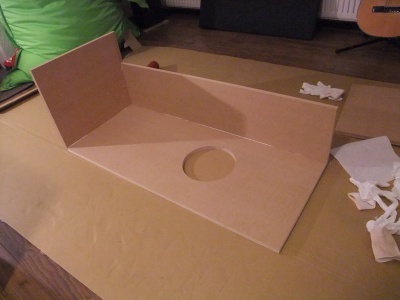 |
||
| After waiting another 15-30 minutes, we mounted the Supravox driver and we could finally listen to the first speaker (for the left-side)! | ||
|
||
| Meanwhile, we made the second speaker (for the right side). The second speaker has the side panel on the other side. In the final setup, the side panels of the speakers will be on the inside. | ||
| Listening (1) | ||
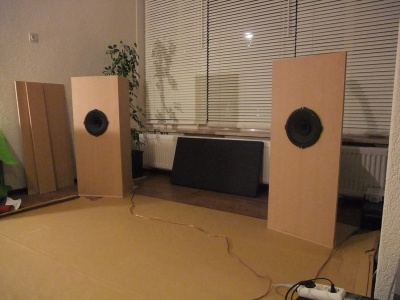 |
||
|
After finishing the second speaker and letting it dry long enough, we could finally set up the speakers and
hear stereo sound.
The first listening session was done with a Creek 4330 MKii amplifier and a historic Philips CD104 CD-player.
Even without equalizer, the speakers sounded fine. The sound was really quick and detailed
and bass was present (though not so much under 50-60 Hz I'd guess). The bass that was present was
very very tight. The voices were clear and direct. Gitars had a well defined attack. Also, the soundstage was
very focused. Even high was well present and detailed, although not as extended sounding as high-end tweeters.
|
||
| Listening (2) | ||
|
The real kicker came after listening to these speakers at my home. Currently I use the Chill-amp II amplifier,
the RME HDSPe AIO sound card as DAC and 47 Labs OTA solid core copper speaker cable. I play with Winamp, FLACs or MP3 decoded with the MAD decoder and an ASIO output plugin. Also, I use a Windows application to equalize the sound. After tuning the equalization settings, the sound is quite spectacular IMHO. I did boost the bass about 7 dB until 280 Hz and the treble above 12 kHz with 7 db too. I could not resist going through a large part of my CD collection and stayed up till 3 o'clock in the night! Vocals are extremely sweet, while staying very clear and understandable. More than enough bass is present and it is very tight. Tracks with nice bass/drums grooves sound really alive and kicking (PRAT). Chill music (e.g. Goldfrapp, Open door, Hotel Costes) sounds really interesting with 3D soundscapes and small detailed crisps. Sound impulses like percussion and drums sound tight and controlled. Brass instruments (Jazz music / big-bands) sound sweet with a nice metallic texture. The sound is well balanced, thus making my whole (?) music collection more than listen-able. Choirs can really sound stunning due to the focused imaging, sweetness and clearness (e.g. Missy Elliot - So addictive). Of course, due to the limited 8" size of the driver and the extra excursion due to LF boost, ear-bleeding levels are not recommended. Still, a reasonable high sound level can be obtained in a normal sized living room (louder would introduce problems with my neighbours anyway ;-). Still, I only have listened to the speakers for one week, so a final verdict has to wait... to be continued... |
||
| Listening (3) - May 2016 update | ||
|
Over the past five years I have listened to the Chill-baffle with much pleasure. My current setup is: - Winamp with MAD decoder and custom output plug-in - Custom software for EQ and minimal oversampling (MOS) - RME HDSPe AIO sound card - Reasonable quality SP-DIF cable - MHDT Paradisea DAC (TDA1545 with tube buffer) - Custom very short silver interlink - Chill-amp II amp - Van den Hul CS-122 speaker cable - Chill-baffle With the current setup I am very satisfied. There is room for improvement but the sound quality is at a level that I can focus on the music instead of the equipment. Also, I can listen to music for extended periods of time without getting listening fatigue (at a reasonable sound level naturally). I may consider to release the custom winamp output plugin and EQ software later in time. It helps to improve the overall sound quality largely. The custom oversampling filtering helps to find a good balance in out of band noise, (lack of ) high frequency attenuation, musicality and timing accuracy. I should make a more decent looking version with multiplex wood instead of MBF. Apart from a better look, I expect that the rigidity of the baffles will be improved. Hopefully I can make some time to make this happen later this year or begin of next year. Additionally, I have plans to try Hypex NCore amplifiers and the Soekris R2R DAC. To be continued... |
||
| Parts | ||
|
The following parts are needed to build the Chill-baffle (prices of 2010):
Optionally, feet could be placed under the bottom plate to let the baffles lean a bit backwards. This way, the speakers will be more in the direction of the ears thus improving the treble response. The total cost of a pair of speakers is under 800 euro. This is not very cheap, but I think it is well worth the money given the obtained sound quality! |
||
| Links | ||
|
Are you open baffled yet? The Supravox homepage |
||
|
I would like to thank Thorsten for pointing me to this great driver and Geert Middel for helping me to build these speakers! Back please!!! |
